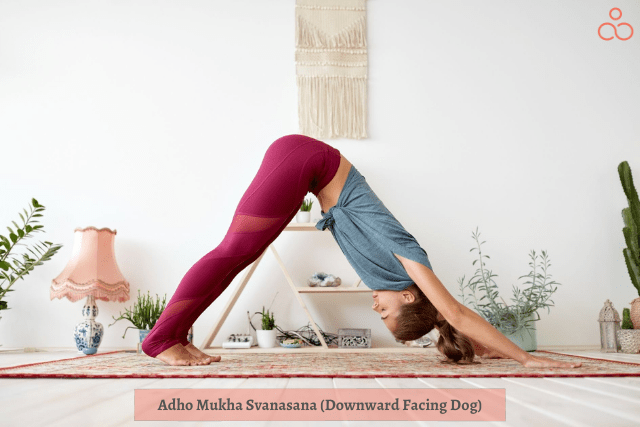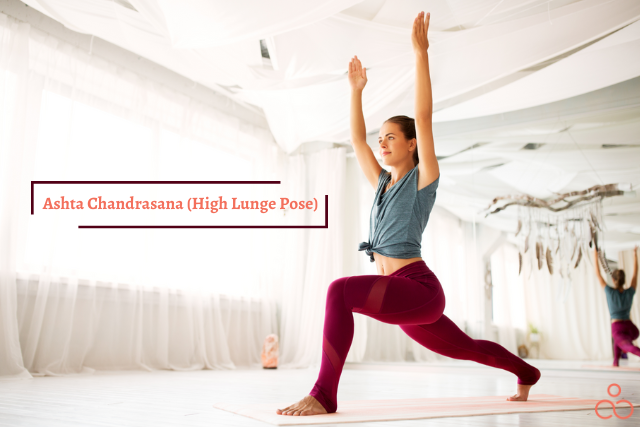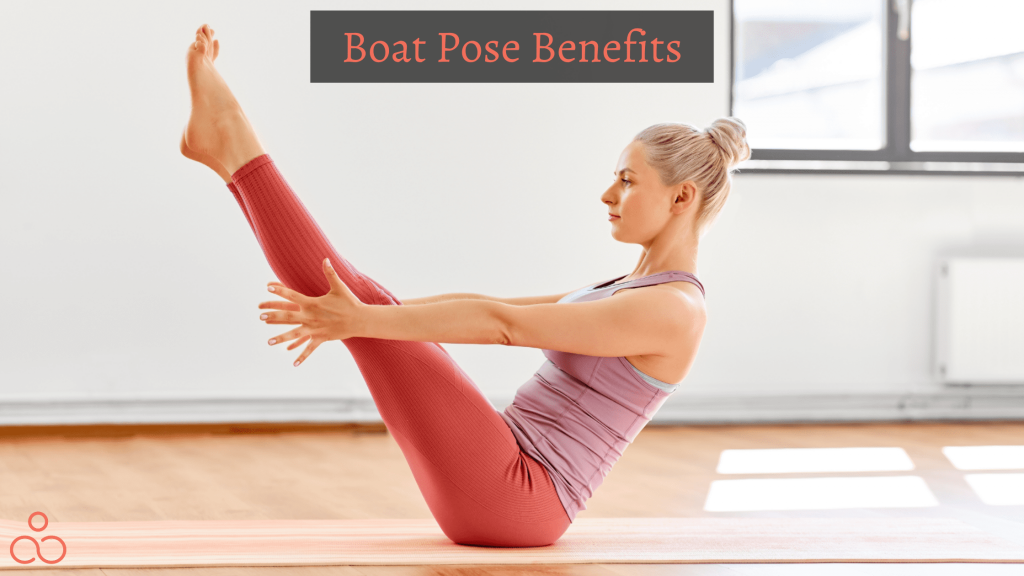Numerous yoga poses, or asanas can help you lose belly fat. Navasana, often known as the Boat Pose, is one of these asanas and it has great belly fat-reducing and core muscle-toning properties. The boat pose works on the core and is a difficult balancing exercise. It can develop tremendous mental strength inside us in addition to physical strength. It accomplishes this by demonstrating to us our capacity to overcome obstacles and by activating the Root and Sacral Chakras. This promotes more self-assurance, a clear sense of identity, and a healthy ego. Let’s understand how to do the complete boat pose and know about some of the crucial boat pose benefits.
What is the meaning of boat pose?
Navasana/Naukasana, often known as “Boat Pose,” is so named because it resembles a boat. The name is made up of the two words “Nauka” (which means boat) and “asana” (which means position). Even before the meditation community started talking about core muscles and dipping into Pilates well enough for new twists and leg lift variants, it had been there for a very long time. This pose is one of the best ways to strengthen your abdominals, which is necessary for many other yoga poses, including gravitational and pull arm balances and inversions.
The mythology behind the boat pose
There are several allusions in ancient Indian literature to the boat, which Sage Manu, the author of Manu Smriti, used to transport the precious Vedas alongside seven other sages during the great flood. The boat was secured to the fish’s horn, and it was successfully towed to a resting area atop Mount Meru. Similarly, there are many other mythological inferences behind the boat pose.
The science behind the boat pose
Navasana bolsters the muscles in the back, hips, thighs, and core. Let’s examine the science of the Boat Pose and how it functions. The most crucial aspect of practicing Navasana is that this pose puts a lot of effort into the muscles in the core. Additionally, the middle back and lower back are simultaneously affected by pressure. The muscles in these places are toned by this pressure. The thigh muscles are then firmed and toned by this asana. Additionally, our hip supports and balances the entire weight while receiving a wonderful massage and conditioning.
Preparing for the boat pose
You should practice several yoga asanas and positions before moving into Boat Pose. Why? Getting your core ready acts as a warm-up, enabling a greater range of motion. You must do it before engaging in the full strengthening stance; otherwise, your lumbar spine may end up compensating.
Here are several methods for warming up the body and the muscles needed for Boat Pose:
- Surya Namaskara or Sun Salutations
- Yogic Bicycles
A short series of postures designed to expand and develop the hip flexors, strengthen the hamstrings, and improve the core are explained below. As a novice, this is a terrific place to start getting ready for Boat Pose!
Here are 4 quick positions you may do to warm up and activate the muscles needed to do the pose correctly before entering the Boat.
Cat-Cow Pose: Cat-Cow is a terrific method to wake up your lower back and get your core ready for some hard work by warming up your spine. Feel out your body as you carefully go through the two stances.
How to do Cat-Cow:
- Start in the Tabletop position with a neutral spine, on all fours.
- To enter Cow, breathe in while lowering your belly, arching your back, and elevating your eyes.
- As you push your hands away from the floor to enter Cat, bring your belly in toward your spine, round your back, tuck your tailbone, and curl your head in toward you.
- At least three times, alternate between these two positions.
Downward Dog Pose: Downward Dog (aka downward facing dog) is a fantastic pre-boat position because it helps you loosen up tight hamstrings, engage your core, and open up your chest.
Performing a Down Dog from a Cat-Cow:
- From the Cat-Cow position, return to a neutral spine. Then, throw your hips up and back while tucking your toes and pushing your hands away from the floor.
- Lift your shoulders away from your ears while extending your arms. To assist you to balance your weight, concentrate on activating your core.
- To help stretch and warm up your hamstrings, pedal one leg at a time.
- Stay for 5 breathes.

The Forearm Plank: A strenuous position that targets the core is the forearm plank. Many individuals find it to be considerably more challenging than a standard plank since the shoulder and core effort is intensified by being on your forearms.
How to do Forearm Plank from Downward Dog Position:
- Come up onto your toes and move your weight forward to enter the Plank Pose from Downward Facing Dog.
- Make sure your body is aligned properly by engaging your core and checking to see if your pelvis is too far off the floor or if your tailbone is sticking out too far into the air.
- Come onto your forearms one at a time while keeping the same position as in the plank. By pressing your forearms into the ground, you may prevent your ears from sagging toward your shoulders.
- Spend five to ten breaths here.
High Lunge: Your hips need to be open for Boat Pose, and High Lunge can assist. You must increase the strength and flexibility of your hip flexors to maintain good alignment and distribute your weight evenly.
Performing a High Lunge from a Forearm Plank:
- Bring your right leg forward and in between your hands as you descend from the forearm plank position. Lift your back leg off the ground while tucking your back toes.
- Lifting your upper body upright while extending your hands upwards requires the utilization of both of your legs as well as your core.
- Pull your right hip back and your left hip forward to make sure your hips are square. Try to sink into the front leg while maintaining a strong core.
- Repeat on the opposite side after remaining here for 5 breaths.

Precautions to follow before getting into the boat pose
You should be aware that this is a precaution before performing any yoga practice. As a result, boat pose precautions include:
- If you’ve recently sustained a neck or back injury, avoid practicing Navasana.
- The Boat position should not be performed if you have cardiac issues.
- Pregnant or menstrual women shouldn’t perform Navasana.
- Avoid doing boat poses if you have any of the following medical conditions: headache, diarrhea, asthma, and insomnia.
How to do the boat pose or sampoorna naukasana?
- Take a seat on the yoga mat with your legs in front of you. Your fingers should point in the direction of your feet as you put your palms on the pavement beside your hips.
- Holding your hands out straight, maintain your back straight. This position is called “Dandasana.” Where “asana” refers to a position and “Dand” refers to a rod.
- Exhale, nudge your upper body back slightly, and simultaneously lift your legs off the ground. Maintain firm, straight knees and rigid legs with your toes pointed in front.
- Your spine should not contact the floor, and you must keep your equilibrium on your buttocks. You must maintain a 60 to 65-degree angle from the floor with your knees higher than your head. As with “Ardh Navasana,” avoid keeping your feet at head height.
- Take your hands off the ground and extend your arms in front of you while maintaining them parallel to the ground and close to your thighs. Your hands should be facing each other and your shoulders should be level.
- With regular breathing, you can maintain this position for around 30 seconds. The asana’s effects won’t be felt for 20 seconds. The duration of the stance can be gradually extended from thirty seconds to around one minute.
- To exit the position, exhale and place your legs and hands on the ground. Lie on your back and relax.
Boat pose variations and modifications
It is well recognized that this position is incredibly adaptable and dynamic. We must work the various layers of the abdominal muscles when working the core. This position may be made more or less difficult, depending on your fitness level, making it easily accessible.
Once you are comfortable with Boat, feel free to attempt some of these enjoyable variants to put your balance and core strength to the test. Remember that you may do all of these variations INCLUDING the adjustments!
- Pose with a boat or a half boat before a low boat: Play with your legs from Full Boat to Half Boat or alternate between Half Boat and Low Boat to increase your core and hip flexor strength. Both variants will test your stability and balance while giving your hips and core a tremendous workout.
- Modified Russian twists or the twisting Boat Pose: As your Russian Twist amplified, this. Try keeping your legs straight (but maintaining appropriate alignment!) Rather than keeping them bent, and slowly rotating from side to side while utilizing your core.
- A brick being squeezed between the thighs or shins: By making your legs bend inward toward one another, squeezing a block between your legs not only aids in maintaining good alignment but also pushes your core to work even harder. Don’t hesitate to give Half Boat a shot as well!
How to change the boat pose?
- Don’t push Full Boat if you’re not comfortable doing it, if you do, you’ll virtually always be practicing with bad alignment. To get the same advantages of the posture, utilize a hand prop or one of the variations listed below.
- From behind, stoop and grip the legs: You might find it challenging to hold your legs up in this posture if you have tight hamstrings or hip flexors. To maintain balance, you can do this by arching your back and slouching your shoulders. Put your hands under your legs to help keep them raised to prevent this.
- Bent knees in the boat position (Half Boat): The boat is frequently modified into a Half Boat, which is also used in many other types of exercise. Knee flexion improves balance while relieving pressure on your hamstrings and hip flexors. The fact that your legs are bent does not automatically indicate that you should not be engaging them. Continue to actively point or flex your toes while keeping both of your legs engaged.
- Pose in a boat while leaning against a wall: If you have weaker hip flexors, placing your feet on the wall during Full Boat might help you keep your balance and concentrate on working your core.
Important: Avoid interfering with the alteration of your back. Come into Half Boat if you find it difficult to keep your legs and back straight.
- A strap around the feet in the boat pose: Yoga straps are beneficial not just for adding length to challenging postures, but may also help you maintain perfect alignment when you need it. Without overtaxing your abdominals, putting a strap around your feet can let you better regulate how high your legs are raised.
Boat pose contraindications
You should be especially cautious and perhaps refrain from doing Boat Pose if you have certain illnesses and diseases. The factors listed below should prompt you to reconsider the position or adjust it if necessary.
- Knee, hip, neck or shoulder injury
- Any recent abdominal surgery
- Indigestion
- Inner ear problems
- Headache
- Sinusitis
- Menstruation
- Pregnancy
- Heart problems
- Low blood pressure
- Osteoporosis
Targeted muscle groups for boat pose
Some of the muscle groups that are targeted during the boat pose are:
- Quads
- Core (Abdominal Muscles)
- Back (Trapezius and Latissimus Dorsi)
- Glutes
- Shoulders
Health Benefits of Boat Pose
- Supports building stronger core muscles: On your back, elevate your head, torso, and legs off the mat by tensing your abdominal muscles. You can keep your balance in the posture by breathing properly.
- Engages Quadriceps: The Boat Pose is a great posture for engaging the hamstrings and quadriceps.
- Helps Alleviate Back Pain: Asana helps to build back and core strength, which can lessen the likelihood of back problems. If you already experience back discomfort, be sure to practice it cautiously.
- Enhances Digestion and Metabolism: Navasana massages the internal organs of the abdomen, which enhances metabolism and digestion. Additionally, this posture aids in igniting the digestive fire, or Agni as it is known in Sanskrit.
- Aids in lowering tension and stress: In Navasana, deep breathing helps to quiet the mind and lessen tension and worry. Before going to sleep or after a long day at work, this stance is excellent.
- Improves Self-Confidence: Focus and attention are necessary for navasana. Your self-confidence might be boosted by practicing this pose regularly.
- Regulates Menstruation: This is a renowned pose for helping to control hormone imbalance and the menstrual cycle. Additionally, it aids with thyroid stimulation and renal toning.
- Activates the Thyroid Glands and the Neck Muscles: The asana aids in the activation of the thyroid glands, which are in charge of creating the hormones that control metabolism, as well as the neck muscles. But make sure your chin is tucked in.
- Activate the Kidneys: Additionally, the asana stimulates the kidneys, which are in charge of cleansing the blood and getting rid of toxins from the body.
FAQs
What are some of the important boat pose benefits?
There are various health benefits of sampoorna navasana or boat pose. Some of them are listed below:
Physical Health Benefits
- Improves flexibility
- Lowers the load on the lumbar spine
- Improves body balance for advanced poses
- Strengthens the abdomen
- Improves digestion
- Activates the reproductive organs in both men as well as women
- Regulates the functioning of thyroid and kidneys
Mental Health Benefits
- Relieves tension and stress
- Enhances focus and concentration
- Improves breath cycles
Why is boat pose so difficult?
Boat posture is challenging for several reasons, one of which is that it demands extremely strong core muscles, which can only be developed via the frequent practice of yoga poses that strengthen the core (abs).
How long to hold the boat pose?
With regular breathing, you can maintain this position for around 30 seconds. The asana’s effects won’t be felt for 20 seconds. The duration of the stance can be gradually extended from 30 seconds to around one minute.
Conclusion
As you get stronger, this stance will get simpler for you. Additionally, as you continue to practice, some arm balances will become easier for you to do. All of this is a result of your foundational effort! Boat posture is a crucial stance to advance your physical practice, even though it is typically not the most gorgeous pose individuals can boast about.

